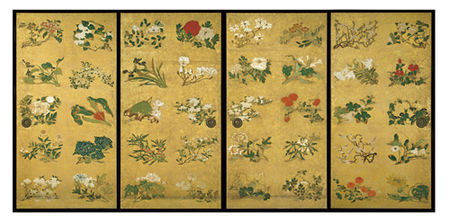"Konpira-San, Sanctuaire de la mer - Trésors de la peinture japonaise" au Musée Guimet
Sanctuaire de Konpira, île de Shikoku, Japon © Keiichi Kawamura/ KOTOHIRA-GU
Le sanctuaire shintô de Kotohira-gu (ou Konpira-gu), point de convergence du culte des montagnes et de croyances relatives à la divinité gardienne des transports maritimes et protectrice des dangers de la mer, fut dès l’époque de Heian (794-1185) un centre de dévotion important, particulièrement populaire et fréquenté à partir du XVIIe siècle. Lieu de pèlerinage célèbre, Kotohira-gu apparaît aussi comme un foyer de création artistique très actif, conservant dans l’enceinte de ses bâtiments de nombreux témoignages picturaux de l’époque d’Edo. Hanamaruzu (Fleurs) Itō Jakuchū (1716-1800) Epoque d’Edo (1615-1867) 1764 Couleurs et particules d’or sur papier Quatre portes coulissantes, paroi sud du Jōdan no ma, Oku-shoin Chaque panneau : H. 177,5 cm ; l. 91 cm Sanctuaire de Konpira, île de Shikoku, Japon © Keiichi Kawamura/ KOTOHIRA-GU L’exposition se propose ainsi de montrer, pour la première fois en dehors du Japon, l’essentiel de ces œuvres, pour la plupart des peintures murales de grande envergure (cloisons coulissantes et paravents) participant de l’architecture intérieure des lieux. La présentation muséographique de celles-ci tendra à rendre compte le plus fidèlement possible de cette dimension singulière de l’aménagement des espaces intérieurs au Japon, appliqué ici à la sphère religieuse. Vue générale des salles des Tigres, des Sept Sages et du Paysage Maruyama Ōkyo (1733-1795) Epoque d’Edo (1615-1867) 1787 Encre, touches de couleur et particules d’or sur papier Quatre portes coulissantes, paroi nord de la salle des Tigres, Omote-shoin Chaque panneau : H. 182,5 cm ; l. 115,5 cm Sanctuaire de Konpira, île de Shikoku, Japon © Keiichi Kawamura/ KOTOHIRA-GU
Tigres, Maruyama Ōkyo (1733-1795) Epoque d’Edo (1615-1867) 1787 Encre, touches de couleur et particules d’or sur papier Quatre portes coulissantes, paroi nord est de la salle des Tigres, Omote-shoin Chaque panneau : H. 182,5 cm ; l. 139 cm Sanctuaire de Konpira, île de Shikoku, Japon © Keiichi Kawamura/ KOTOHIRA-GU Ce sont donc de grands noms de la peinture japonaise qui seront évoqués, au travers d’œuvres célèbres dont beaucoup sont aujourd’hui classées Bien Culturels Importants. Si de rares paravents permettront d’illustrer les grands courants de la création picturale à l’époque Momoyama, notamment l’école Kanô (« Cèdres et Mont Fuji », paravent attribué à Kanô Eitoku) et l’école Tosa (paire de paravents illustrant des scènes du Genji Monogatari par Tosa Mitsumoto), ce sont surtout deux grands noms de la peinture du XVIIIe siècle qui seront par le biais de cette exposition magistralement représentés : Maruyama Ôkyo (1733-1795) et Itô Jakuchû (1716-1800). Des peintures à l’huile de Takahashi Yuichi (1828-1894) témoigneront de la portée des influences occidentales sur la création picturale de l’ère Méiji. Jeune pin et grues, Maruyama Ōkyo (1733-1795), Epoque d'Edo (1615-1868), 1787, Encre, couleurs légères et particules d'or sur papier, Quatre portes coulissantes, paroi nord de la salle des grues, Omote-shoin, Chaque panneau : H. 182,5 cm; l. 91,5 cm. Sanctuaire de Konpira, île de Shikoku, Japon. © Keiichi Kawamura/ KOTOHIRA-GU.
PARIS.- Musee National des Arts Asiatiques Guimet presents Treasures of Japanese Painting Konpira-San - Sanctuary of the Sea, on view through December 8, 2008. This exhibition, jointly organized by the office of Kotohira-gű and the Guimet museum is part of the commemoration of the 150th anniversary of diplomatic relations between France Japan. It is the perfect opportunity to admire major works from the XVIIIth century and to talk about Shintoism, the animist type religion proper to the Japanese archipelago.
The Shinto sanctuary of Konpira (or Kotohira-gű), a crossroad for the cult of the mountain and beliefs linked to the divinity that guarded sea transports and protected from the dangers of the sea, was since the time of Heian (794-1185) an important center of devotion, attended in particular as of the XVIIth century. A song that tells of the pilgrimages of boats from Konpira that sailed Japan’s Internal Sea, bears witness to the popularity of this famous pilgrimage site. Pilgrims from all over have converged towards this town, located in the island of Shikoku, to pray in the holy place, where the quietness contrasts with the bustling of the markets and theaters.
Konpira-san appears as a very active center of artistic creativity, that has kept inside the walls of its buildings numerous pictorial proofs of the Edo period. Both a venue of spirituality and culture, it has supported the arts and sciences since the Edo period and holds over 6000 works. The exhibition aims at showing, for the first time outside of Japan, a part of these works, most of them very large mural paintings (screens and sliding partitions) that participate in the site’s interior architecture. Their museum presentation will focus on rendering as faithfully as possible this unique dimension of the manner in which interior space is arranged in Japan, here applied to the religious sphere, in order to allow visitors to feel the spiritual world of Kotohira-gű where nature and culture are united.
The delicate cranes with their white necks, visible in the fresco Reeds and wild geese are side by side with paintings of majestic tigers. While screens illustrate the major currents of pictorial creation during the Momoyama period, in particular the Kanô school (Cedars and Mount Fuji, a screen attributed to Kanô Eitoku) and the school of Tosa (pair of screens illustrating scenes of Genji Monogatari by Tosa Mitsumoto), this exhibition brilliantly represents two great names in XVIIIth century painting: Maruyama Ôkyo (1733-1795) and Itô Jakuchű (1716-1800), whose famous works are considered today Important Cultural Goods. In the last part of the exhibition, the contemporary works of Takubo Kyôji, the cultural counselor of the sanctuary and a major Japanese artist who produced frescoes 4 meters tall and 25 meters long, ally delicateness and monumentality around camellias in indigo colors, the symbols of renaissance of the Kotohira- gű.
Du 15 octobre au 8 décembre 2008

/https%3A%2F%2Fprofilepics.canalblog.com%2Fprofilepics%2F1%2F0%2F100183.jpg)
/https%3A%2F%2Fstorage.canalblog.com%2F03%2F02%2F119589%2F96711876_o.jpg)
/https%3A%2F%2Fstorage.canalblog.com%2F11%2F31%2F119589%2F94773502_o.jpg)
/https%3A%2F%2Fstorage.canalblog.com%2F20%2F83%2F119589%2F94772815_o.jpg)
/https%3A%2F%2Fstorage.canalblog.com%2F26%2F72%2F119589%2F75604929_o.jpg)
/https%3A%2F%2Fstorage.canalblog.com%2F59%2F60%2F119589%2F26458628_o.jpg)







/http%3A%2F%2Fstorage.canalblog.com%2F29%2F49%2F119589%2F128916863_o.jpg)
/http%3A%2F%2Fstorage.canalblog.com%2F67%2F73%2F119589%2F122425453_o.jpg)
/http%3A%2F%2Fstorage.canalblog.com%2F58%2F96%2F119589%2F113162735_o.jpg)
/http%3A%2F%2Fstorage.canalblog.com%2F12%2F07%2F119589%2F111686796_o.jpg)